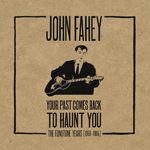|
|
 |
Dusted Reviews
Artist: John Fahey Album: Your Past Comes Back to Haunt You: The Fonotone Years [1958-1965] Label: Dust-to-Digital Review date: Jan. 13, 2012 |

|
|
|
 |
“I stole that last chord from Holst,” says John Fahey laconically in a 1969 interview. It’s as if there was nothing unnatural at all about a supposed folk guitarist stealing a dissonance or two from an early 20th century British composer. This point-blank but selective representation of his past, whimsical and bitter by turn, would be the norm as Fahey pursued his winding road of loneliness and alienation. Now, Dust-to-Digital allows us a more panoramic view of the past he would rather we forgot, or maybe never knew.
If ever there was a box set to which the old chestnut “Warts and All” applied, it’s Your Past Comes Back to Haunt You. No one knows that better than Glenn Jones, the long-time John Fahey enthusiast and a compiler of this five-disc compendium of Fahey’s earliest recordings. He is the first to admit that some of this material is simply excruciating listening, but he is persuasive about its historical importance. The music ultimately proves him right. This portrait of artistic development should be heard by those interested in the massive body of work to follow. The material on offer emerges as the first landmark on the path that would take Fahey from his gentler but iconoclastic acoustic musings, through the more radical, surreal, world-music-infused experiments of the 1960s, like the musique concrete experiments at the end of the fifth disc, toward the wistful and shattering electric rhuminations of his final years when long-overdue recognition was finally bestowed on him. This set is perhaps the most important manifestation of that homage.
Any Fahey enthusiast knows the history, the attendant mythology and, most likely, a good portion of the recordings on offer, as they’ve circulated widely for years. They tell the story of a teenager in late 1950s Washington D.C. enamored of a time long gone, an epoch of which the newly emergent rock ‘n’ roll seemed a pale imitation. Fahey learned the ropes, in part, from record collector and Fonotone mogle Joe Bussard (which is apparently pronounced Buzzard). In the brief 1967 interview snippet that opens the collection, with clinking glasses and the lighting of matches as ambiance, Fahey talks about evenings getting smashed and engaging in rowdy emulation of the old records he was then discovering. He’d affect Charlie Patton’s growl and Mississippi John Hurt’s playing style, figures now as legendary as they are ubiquitous but then almost unknown. Bussard would capture it all on tape. Later, as Fahey’s circle of travel widened, he would send material to Bussard for possible release, keeping other things for his own Takoma label. We can hear the various techniques he was cultivating improve as the sessions progress, and he moves from imitator to stylist.
I have portrayed Fahey’s development as more of a linear progression than it really was, another element this set makes plain. True, we hear his slide playing improve over two or three years and the wildly guttural ramblings of Blind Thomas, the first of Fahey’s adopted personas, preceding the better-known Blind Joe Death. Then, amidst the blatant homages, such as the lyrically incorrect version of Patton’s “Mississippi Boweavil Blues,” also credited to Blind Thomas and which probably needs only one listening, we find the earliest versions of The Legend Of Blind Joe Death’s “The Transcendental Waterfall.” Here, we are given two early versions recorded within months of each other (bringing the total number now available to five). The comparison is fascinating. “Waterfall” is one of the earliest examples of Fahey the composer, one of those instances where the convergence of “folk” and “classical” idioms occurs in his emerging voice. The piece is prophetic of the large-scale compositions to come in the 1960s, such as the astonishing “Great San Bernardino Birthday Party,” but in its early incarnations, the juxtaposed ingredients are more plainly audible as Fahey develops his craft.
The music is great, but the documentation may be even better. In these days of downsizing, it is rare to see annotation of this scope and caliber in a box set. There are detailed notes on every track, and, where necessary, its origins in other compositions and complete discographical material; there’s a never-before published interview with Fahey from 1967, essays from friends and early associates, and even a scholarly treatise on how the Fonotone record labels changed in appearance. Misspellings have been corrected, many untitled pieces have received correct attribution, and the sound is as good as it’s going to get. Most of the recordings have been transferred from original tapes, and speed correction has been applied where necessary and documented in the accompanying notes. There’s also a slew of previously unpublished photographs, including the earliest in existence of Fahey with a guitar; the cache came from his mother, retrieved by Jones after Fahey’s death in 2001. Fahey himself knew of the set in its earliest planning stages, and he was hot and cold on the project. I can’t help but believe that he would have been proud of the efforts put forth by the team of experts assembled to piece together this part of the Fahey puzzle.
By Marc Medwin
|







